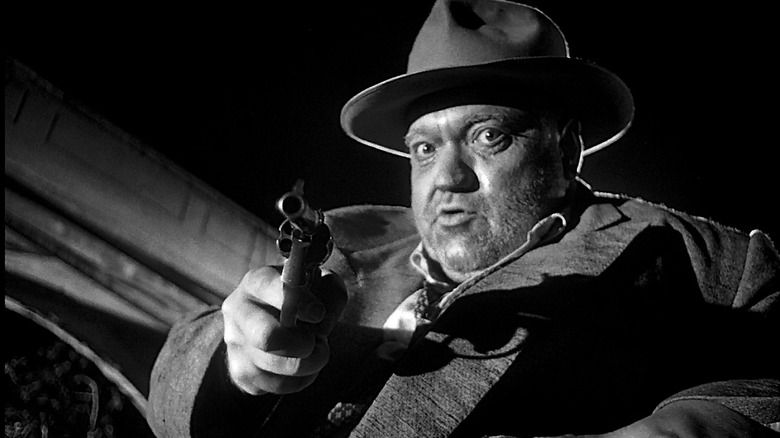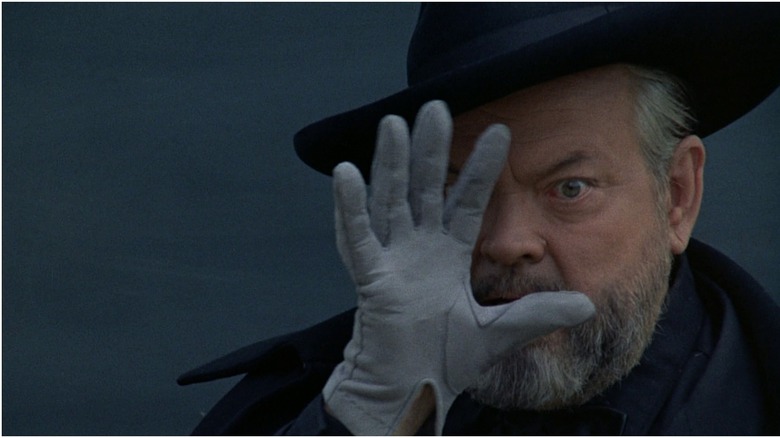A Stroke Of Luck Saved Orson Welles' Touch Of Evil
If you think being the creative mastermind behind the greatest movie ever made would guarantee you a prosperous Hollywood career, you'd be wrong. Orson Welles never again enjoyed the creative freedom he had on "Citizen Kane." He still tried to stick it out in Hollywood for awhile, directing and starring in films like "The Stranger" for RKO Radio Pictures and "The Lady from Shanghai" for Columbia. By the end of the 1950s, he called it quits, relocated to Europe, and only ever returned to Hollywood to act. The last film he directed for an American studio was "Touch Of Evil," a 1958 film noir for Universal. However, it took a long time for audiences to see the movie as he envisioned it.
How Welles got the directing job
Originally, Universal only wanted Welles to play the film's villain, corrupt police captain Hank Quinlan. Luckily for Welles, he had an advocate: Charlton Heston, who starred in "Touch of Evil" as Mexican prosecutor Ramon Vargas (yeah, even great films can have undeniable faults).
As Heston recounted in his autobiography, "In the Arena":
"We've got Orson Welles to play the heavy, though. Now I paused. Could they really not have thought of the obvious? 'Why don't you ask him to direct, too? He's a pretty good director, you know.' Well... you'd have thought I'd suggested that my mother direct the film. 'Oh! Ahh, yes, 'Citizen Kane' and... umm... yes. Interesting. It would be, that is. To direct. For him... ah, to direct. The film. We'll, ahh, get back to you. On that.' Whereupon I hung up, bemused. They did get back, a few days later. Yes, Orson would direct the film. I have no idea how intense the debate was, but I doubt anyone at Universal slapped the back of his head and said, 'Of course he should direct! How come we didn't think of it? What a smart guy that Chuck Heston is.' More likely it was, 'Ahh, let him direct it. How bad can it be? Heston'll just get sore if we don't. F***in' actors."
As it turned out, Welles had another ally, Universal's staff producer Albert Zugsmith, who kept on-set interference to a minimum. From there, pre-production and principal photography for "Touch of Evil" proceeded with little issue. Welles had gone into "Touch of Evil" hoping that the project would be his Hollywood comeback as a director, and when Universal floated a five-picture deal, it seemed his dreams would come true. Alas, post-production then began.
The studio interference begins
On Welles' second film, "The Magnificent Ambersons," RKO Pictures took control of the edit, restructuring sequences and adding in new material Welles had not shot. History repeated itself with "Touch of Evil." In contrast to his workman-like pace on set, Welles took his sweet time in the editing room and Universal executives grew impatient. Zugsmith had also since left Universal for MGM, meaning Welles had no one on his side. Even after being removed from the editing room, Welles wasn't willing to surrender. He appealed to the studio with a 58-page memo outlining his creative choices, but Universal heeded little of his insight. The "Touch of Evil" cut that premiered in 1958 (as a B-picture beneath Harry Keller's "The Female Animal") was not Welles' preferred version.
Welles was understandably dismayed by this turn of events. As he recounted to Peter Bogdanovich in the book "This is Orson Welles":
"I was so heartbroken when it turned out I couldn't go on with it. I was so sure I was going to go on making a lot of pictures at Universal, when suddenly I was fired from the lot. A terribly traumatic experience. Because I was so sure... It's the only trouble I've ever had that I can't begin to fathom."
A vision restored
"Touch of Evil" met a muted reception, critically and financially, on initial release. However, that was not the end of its story. The film featured at the 1958 Brussels World Fair, where Francois Truffaut and Jean-Luc Godard judged it positively; as was often the case with Welles, Europe was more accepting of him than his homeland was. From there, "Touch of Evil" gradually rose in estimation. In 1976, Universal rediscovered and released a 108-minute print of the film. This restored some of Welles' intent but was still not the picture he envisioned. The closest approximation to "Touch of Evil" as Welles wanted it came in 1998, after his death. Using the memo as a guide, legendary editor Walter Murch led a team of film editors to recut "Touch of Evil" as Welles had meant for it to be assembled.
"The 50 changes that were made did not transform the film into something completely different: we did not find the equivalent of the missing last reel of Welles's ”Magnificent Ambersons,” for instance. This ”Touch of Evil” is simply a better version of the same film, which is to say, more in line with the director's vision, more self-consistent, more resonant, more confidently modulated, clearer. In other words, more as it should have been in the first place."
The Murch cut runs 111 minutes, 16 minutes longer than the 1958 theatrical edition. The cut removes all footage that Welles didn't shoot himself while rearranging the editing. For instance, Welles intended the film's famous opening sequence, a one-take crane shot following a car bomb moving through a city, to have a diegetic score. The studio cut instead used this opening for a bog-standard title sequence. "By removing the titles and having this sort of freeform music, it puts a suspense under this scene that didn't really exist before," explained Murch.
Edited from existence
As Welles explained in an interview with Cahiers du Cinéma (the same publication which labeled "Touch of Evil" the "best B-movie ever made"), he considered editing to be the most important part of filmmaking. As he put it, "[Editing] is the only moment where [the director] completely controls the form of his film." Welles' fascination with editing is clear in 1973's "F for Fake," the last film of his released during his lifetime. The film blends documentary and narrative, weaving together real and staged footage to tell the history of art forgery.
If one agrees with Welles' view on editing, that means the world has very few tastes of Welles' unaltered vision. For one, the only finished films in which he had final cut were "Citizen Kane" and "Othello." "Touch of Evil" is also not the only Welles film with multiple versions; "Mr. Arkadin"/"Confidential Report" has acquired seven different cuts, including a Spanish language version. In an echo of Murch's restoration of "Touch of Evil," the Munich Film Archive re-edited "Mr. Arkadin" in 2006 in line with Welles' intent, creating as close to a definitive version as possible. Yet, without Welles himself around to oversee these projects, such restorations have only a tenuous claim to being his preferred version.
The genius artist struggling against the wishes of corporate bosses and the currents of capitalism is a cliché, but Welles' life shows that clichés have a basis in fact. Considering how often Welles struggled to complete even one project, we should count ourselves lucky that the 1998 "Touch of Evil" restoration gives us a glimpse of what he envisioned.




